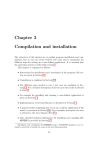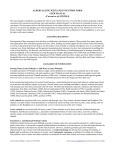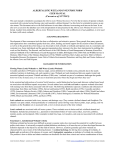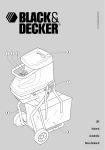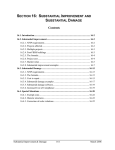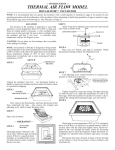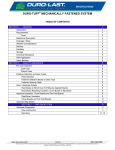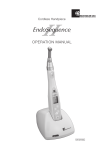Download Chapter 5 - Santa Clara Valley Water District
Transcript
C HAPTER 5 GUIDANCE FOR HOMEOWNERS 5A. HOW TO PLAN YOUR STREAMSIDE PROJECT This chapter targets streamside property owners who are planning on: • • Building a new home near or next to a stream Adding new floor space onto an existing home near or next to a stream 5B. WHY CONSIDER LOCAL STREAM RE SOURCES WHEN BUILDING OR REMODELING YOUR HOME? A stream is more than just a channel for rainwater in its passage to the Bay. It is a complex, living system where the characteristics of the streambed—its composition, shape, and elevation drop— interact with the dissolved nutrients and organic matter in flowing water to create a dynamic environment rich with plant, animal, and fish life. A number of conditions typify natural streams in their pristine state. These include cool, clear, oxygen-rich water free of contaminants and excess algae; plenty of clean gravel for fish spawning and aquatic insects; a balance of fast, flowing water for spawning and feeding; slow, calm pools for rest; and streamside vegetation to provide shade and food. Human activities can influence all of these factors. Many animals and plants make their home in the narrow corridor of streamside vegetation known as riparian habitat—the area immediately adjacent to your stream. This high-moisture environment, which covers only a small percentage of the County’s watershed, provides food and shelter for a greater variety of wildlife than any other habitat type. This zone is also critical as a migration corridor for many animals, especially where nearby development acts as a barrier to overland travel. A river seems a magic thing. A magic, moving, living part of the very itself – for it is from the soil, both from its depth and from its surface, that a river has its beginning. —Laura Gilpin, The Rio Grande, 1949 In addition to the biological function of a stream ,the gravel bed provides a conduit for groundwater recharge and ultimately water supply. The stream provides a conduit for conveying drainage water from the land surface including our streets and yards and provides for the conveyance of food water. Too much water from roofs and paved surfaces in an urban environment has impacts on the stability of the stream channels. The velocity of the water increases which causes erosion and down cutting of the channel. Higher flows can also increase the frequency and depth of flooding. In addition to physical changes to the stream, pollutants from streets and hardened surfaces are carried to the stream, the temperature of the runoff is increased impacting the water quality. USER MANUAL: GUIDELINES & STANDARDS FOR LAND USE NEAR STREAMS 5.1 G U I DA N C E F OR HOMEOWNERS Even if the stream on or next to your property has been modified and no longer looks like a natural stream corridor, this guidance is still applicable. The water in the stream either flows to another stream or is carried to the Bay, in which case the water quality and stream bank protection concerns are still applicable. In any case, protection or enhancement of the stream corridor will always be betterment to the environment. 6. Helping Mother Nature: As many urban and suburban streams have been degraded, opportunities abound for homeowners to restore environmental conditions of local streams, including erosion and streambank repair measures, planting of trees and shrubs suitable to your watershed, and joining with your neighbors to restore a reach of stream. If you incorporate the natural features of a stream into your building plans, you will benefit in these ways: 7. Open Space and Recreation: Healthy and intact stream ecosystems are a ready-made open space area for wildlife viewing that can be incorporated in your landscape design, while adding pleasure and amenity to your streamside property. 1. Shade Trees: Retention of riparian trees can provide a shade canopy for outside uses, and provide for cooler temperatures inside a home during hot summer months. 2. Safe Slopes: By not building on or next to streambanks the potential for eroding and destabilizing such slopes, and related impacts to health and safety are reduced. 3. Stream Stability: By not placing structures between stream banks, and by reducing the amount of pavement and other impervious surfaces adjacent to a stream, including directing drainage from roofs, driveways and patios away from streams, you will be contributing to stream stability. 4. Clean Water: The water quality in local streams and the receiving waters of the bays and ocean will benefit if surface water is directed to vegetated areas before it flows into streams. 5. Wildlife and Aquatic Life: Wildlife, such as resident and migratory birds, small mammals, fish and other aquatic life have a better chance of surviving in the urban environment if measures are taken to protect native vegetation, if newly planted vegetation is specific to your watershed and if streams are kept in the most natural condition possible. 5.2 8. Buffers Between Homes: By preserving and maintaining riparian trees and vegetation, and siting structures appropriately, you can maintain or create a visual and physical buffer between other homes in the neighborhood, adding to the privacy and enjoyment of your streamside house. 5 C . W H AT P E R M I T S D O I N E E D ? Please consult with your local building department and ask what permits you need to build a new home or expand an existing home. Some communities only require a building permit while others require discretionary design review. If you are planning to modify a streambank or streambed, you will probably need permits from the California Department of Fish and Game, the Regional Water Quality Control Board and the U.S. Army Corps of Engineers( see Chapter 2, Section K for contact information for permitting agencies). The mission of these agencies includes protection of stream habitats, water flows and water quality, so they will help to provide guidance for your project. USER MANUAL: GUIDELINES & STANDARDS FOR LAND USE NEAR STREAMS GUIDANCE FOR HOME O W N E R S If your project is adjacent to a SCVWD facility or right-of-way, or if your local jurisdiction has chosen not to administer streamside permitting, a SCVWD permit is required. Please contact the SCVWD’s Community Projects Review Unit at (408) 265-2607, ext. 2650 to find how to obtain a SCVWD permit. Information is also available at : http://www.valleywater.or/Business_ Info_and_Permits/Permits/index.shtm. 5 E . S T E P- B Y- S T E P P R O C E S S F O R U S I N G T H E P E R M I T T I N G TO O L S 5D. HOW TO USE THE STREAMSIDE PERMITTING TOOLS AND GUIDELINES AND STANDARDS FOR LAND USE NEAR STREAMS Step 1: See the List of Exempt Activities below, a-g. If the construction you are planning falls into one of the exempt categories (listed below), no special streamside requirements apply. As part of a multi-year cooperative process, all of the cities in Santa Clara County, the County, the Santa Clara Valley Water District as well as environmental, business, agricultural and community organizations developed a set of Guidelines and Standards for Land Use Near Streams, which are listed in Chapter 3 of this User Manual. Each local jurisdiction will decide how the Guidelines and Standards are administered and how they may apply to new homes and expansion of existing homes. Please consult with planning or building officials in your local jurisdiction to find out how the Guidelines and Standards apply to you. In Chapter 2 of this User Manual there are several tools to help you prepare for obtaining a permit to build or remodel a home on your streamside property. If you wish, before you go to your local building or planning department, you can follow these seven steps, to start planning your home while preserving the stream and streamside ecosystem: List of Exempt Activities a. Less then 3 cubic yards of earthwork; or, b. Interior building construction and alterations; or, c. Erection of storage buildings not greater than 120 sq. ft.; or, d. Replacement of sewer or water laterals; or, e. Re-roofing; or, f. Wood fences six feet and height or less; or, g. Exterior decks less or equal to 30” above grade. Interior construction (b), replacement of sewer laterals (d), and reroofing are subject to local building permit requirements. In most jurisdictions minor grading (a), small storage buidings (c), fencing (f) and low decks are not subject to building permits. However, if you do plan on adding a storage shed, a fence or a deck, please consider how to design, site and build them in a manner that causes the least disruption to the stream and streamside resources. Decks should not overhang or extend beyond the creek bank. Fences should also be set back from the top of the bank. USER MANUAL: GUIDELINES & STANDARDS FOR LAND USE NEAR STREAMS 5.3 G U I DA N C E F OR HOMEOWNERS Ask your local building department for information that describes how to build exempt improvements so they cause the least disruption to the stream and streamside ecosystem. Step 2: Determine whether or not your parcel is defined as a streamside parcel. If any portion of the parcel is within 50 ft. of the top of the streambank on or nearest to your parcel, the answer is ‘yes’. See the following sections in Chapter 2 of this User Manual for reference material to help determine if your parcel is defined as a streamside parcel: - 2D. Designation of Streamside Review Area - 2E. Definition of a Stream - 2F. Criteria to Identify or Verify a Watercourse as a Stream - 2G. Definition of Top of Bank Step 3: See the list of Streamside Resource Protection Questions for Single-Family Units, Chapter 2, Section I in this User Manual.1 Answer the questions to the best of your ability. If you need help answering any of the questions, consult with your architect or local building department. Step 4: See the Information to be Included on Plans for Streamside Development, Chapter 2, Section J in this User Manual. By including the information described, you can create a site plan which integrates the stream and streamside resources into your building plans. The Streamside Resource Protection Questions for Single-Family Units (see Step 3 above) will provide the basis for much of the information you will need to include on the site plan. Step 5: See the section below titled Slope Stability Protection Area for Single-Family Homes. Determine how the Slope Stability Protection Area needs to be accommodated by your Site Plan. If the top of bank is not easily determined by visual inspection, see Chapter 2, Section G of this User Manual for a detailed description on how to determine the top of the streambank. 5 F. S LO P E S TA B I L I T Y P R OT E C T I O N A R E A F O R S I N G L E - FA M I LY H O M E S. The Slope Stability Protection Area is an area between a structure and the stream2. The purpose of the Slope Stability Protection Area is to prevent: 1) Problems with slope stability and erosion, and related hazards to structures, public health and safety; 2) Adverse effects on flood control and drainage facilities and related infrastructure; and, 3) Adverse effects on streams and riparian corridors, including stream-dependent vegetation. The width of the Slope Stability Protection Area will vary depending on the depth of the stream from the top of bank to the bottom, the condition of the stream and the steepness of the bank. Generally, the width of the Slope Stability Protection Area will be between 10-25 ft. from top of bank, but this may be different depending on site and streambank conditions. Building within the Slope Stability Protection Area is discouraged; however, if your plans include building within that area or if the affected stream is deeply incised or has highly erodable banks, the building department in your community may ask you to hire a licensed expert to conduct a 1 Your local building department may use this same list of Questions, or may have changed their format by adding them to an existing permit questionnaire. Either way, completing the Questions will help provide information helpful to building on a streamside lot that causes the least disruption to the stream and streamside resources. 2 . In addition to protecting this area, BMP’s should be used that are reflective of Guidelines and Standards, for activities adjacent to this areas where discretionary review is used (i.e redirecting drainage away from the stream and no removal of native riparian plants). 5.4 USER MANUAL: GUIDELINES & STANDARDS FOR LAND USE NEAR STREAMS GUIDANCE FOR HOME O W N E R S geotechnical analysis of slope stability on your property. The purpose of this analysis is to assure that the building will not be damaged if the stream erodes or fails and that the stream bank will not be damaged by the construction and placement of the structure. If a new home or remodel requires discretionary review by your local planning department, you will be asked to pay special attention to directing surface drainage away from the stream and possibly take measures to increase the Slope Stability Protection Area to better protect any structures and streams from possible impacts. Some communities may adopt exemptions to existing single-family homes, which are built on lots 10,000 sq. ft .or less. The exact lot size subject to exemption may vary from community to community. Please consult with building officials in your community to find out how the Slope Stability Requirements may affect your property. See Appendix C to this User Manual for a complete description of the Slope Stability Requirements for Single-Family Units on Streamside Properties. Step 6: See the Guidelines and Standards for Land Use Near Streams, Chapter 3, Section B of this User Manual. Review the Guidelines and Standards, starting with section I, Riparian Corridor Protection, and proceeding to section XIV, Flood Protection. Consider how you can incorporate the recommendations in the Guidelines and Standards into your single-family home site plan to protect stream and streamside resources. Also refer to the Best Management Practices for SingleFamily Homes listed below. 5 G. B E S T M A N AG E M E N T P R AC T I C E S F O R S I N G L E - FA M I LY HOMES The following Best Management Practices (BMP’s) have been developed to support the protection of streamside natural resources on parcels where single-family development is planned. The goals of the BMP’s are: a. To take advantage of the stream and streamside resources on your property by designing and locating improvements to be in harmony with them. b. To incorporate stream and streamside resources into your development plans in a way that leaves natural stream systems intact. c. To take opportunity where possible to prevent or address problems, such as bank erosion and/or spreading invasive species, while improving the existing conditions of the stream and/or streamside environment. The BMP’s for single-family homes are: 1. Water Quality: a. Direct surface drainage away from streams and do not allow water to sheet flow over the stream bank. b. Encourage infiltration by minimizing paving materials and installing pervious materials such as porous pavement. c. Use vegetated buffer zones to reduce surface runoff into streams. d. Plant landscape materials that minimize the use of pesticides and fertilizers. Use organic soil amendments rather than chemical fertilizers. e. Do not drain pools or spas to the storm drain, gutter or creek. Chlorine and copper algaecides are toxic to aquatic life. Drain to sanitary sewer or let chlorine dissipate for two weeks and drain to landscaping. USER MANUAL: GUIDELINES & STANDARDS FOR LAND USE NEAR STREAMS 5.5 G U I DA N C E F OR HOMEOWNERS f. Dispose of vegetation debris, lawn clippings and animal waste with your household trash. Although biodegradable, too much organic material degrades the riparian habitat. 2. Stream Banks and Streambeds: a. Preserve existing riparian vegetation. b. Keep structures out of the stream zone. Stairs and retaining walls can degrade creek banks and impact your neighbor’s stream bank. c. Drain roof gutters to landscaped areas or to the street. Pipes draining onto or overhanging the stream bank cause erosion. d. Don’t dam or take water from the stream. e. Monitor the stream bank condition. Replant barren or disturbed slopes as soon as possible or provide erosion blanket or straw to protect slope until permanent vegetation is established. f. Do not use tires or broken concrete for erosion repair or slope protection. g. Eroded stream banks should be repaired with ‘soft’ methods, such as geotextiles or soil filled mats or for severely eroded areas boulders interspersed with willow wattles. Seek professional help with this work to ensure proper technique and that there are no impacts to your neighbors. h. If possible, coordinate with upstream or downstream property owners to 5.6 design and implement streambed or streambank improvements for a reach of stream. 3. Riparian Vegetation: a. Plant riparian vegetation to provide shading of streams, where possible. b. When planting new vegetation in riparian areas: 1. Use native watershed-specific plants or non-local California natives. See plant lists in Chapter 4- Design Guides. 2. Exclude invasive plants from your landscaping plan. Refer to the list of invasive plants in Chapter 4- Design Guides c. Do not place structures within the drip line of mature riparian trees, such as oak, sycamore, alder, etc. d. New native plantings may need irrigation to help ensure establishment but should be weaned from irrigation for long term survival e. Remove invasive plants from riparian corridors, especially those which spread rapidly and degrade riparian habitat, such as pampas grass (Cortaderia selloana) and Arundo donax. USER MANUAL: GUIDELINES & STANDARDS FOR LAND USE NEAR STREAMS GUIDANCE FOR HOME O W N E R S 4. Fisheries: a. Preserve in-stream and near-stream riparian vegetation whose canopies provide shade and nutrients for aquatic life. b. Avoid removing woody debris, which provides fish habitat in streams unless it poses a flooding or erosion threat. Step 7: See the Construction-related Permit Conditions for Streamside Permits, Chapter 2, Section L of this User Manual, for ways to protect stream and streamside resources during the construction phase of your project. 5H. TECHNICAL ASSISTANCE When considering how to use the BMP’s, especially if you are planning to make improvements to, or reconfigure the stream channel or stream bank, you can call the Community Projects Unit of the Santa Clara Valley Water District: (408) 265-2607 x 2650 for assistance. Please consult with planning or building officials in your community to find out how the Guidelines and Standards apply to your site and your project. 5 I . R E L AT E D I N F O R M AT I O N AND PROGRAMS FOR STREAM S T E WA R D S H I P There are a variety of programs available to assist homeowners and community groups in promoting stream stewardship. The programs and information listed below are available through the Santa Clara Valley Water District. Other programs are also available through a variety of other agencies. Stewardship for Small Acreages Workshops The SCVWD sponsors the Stewardship for Small Acreages program which provides an annual series of educational workshops for landowners on how to attain their property goals while protecting soil, water, plant, animal and other natural resources. The goal is to help reduce pollution entering storm and surface water from residential and agricultural properties by sharing the knowledge and skills necessary to manage land and animals in a way that helps keep water clean. The program targets more than 5000 landowners in the Uvas/Llagas Watershed who own between one and sixty acres of land and is co-sponsored with the Loma Prieta Resource Conservation District and the University of California Cooperative Extension. Specific workshop topics have included: well and septic system maintenance, general storage and disposal issues, landscape design, native plant selection, erosion control, small vineyard nutrient and fertilizer management, composting, fire safety and water conservation. USER MANUAL: GUIDELINES & STANDARDS FOR LAND USE NEAR STREAMS 5.7 G U I DA N C E F OR HOMEOWNERS Watershed Stewardship Grant Program The SCVWD sponsors the Watershed Stewardship Grant Program to support community-based, non-profit organizations in their watershed stewardship efforts to enhance ecosystem health, water supply, and water quality in Santa Clara County. The program aims to provide communitybased, non-profit organizations with the tools and resources to improve ecosystem quality in Santa Clara County and to promote awareness, education, and research related to ecosystem sustainability. Since the program’s inception in 2001, more than $300,000 in grant funding has been awarded to community groups. Adopt-A-Creek and Creek Connections Volunteer Programs The SCVWD’s Adopt-A-Creek and Creek Connections volunteer programs provide the opportunity for community members to have a hands-on experience in improving the condition of local waterways. Adopt-ACreek is a formalized program that allows schools, businesses or community groups to care for a specific stretch of SCVWDowned creek for a minimum two year period. The SCVWD provides supplies, such as trash bags, and hauls away the debris collected by volunteers. Hundreds of groups have participated in the program since its inception in 1993. Creek Connections sponsors two countywide creek clean-up in conjunction with California Coastal Cleanup Day and National River Cleanup Day. These events provide an opportunity for spontaneous “drop-in” participation. More than 10,000 volunteers have participated in Creek Connections events since 1996. School Programs The SCVWD offers classroom presentations on watersheds, flood plains, run-off, flood protection, creek ecology and clean water. Presentations feature hands-on, interactive activities, including a watershed diorama and bay pollution activity. There are also several original watershed songs that have been incorporated into the curriculum. Many teachers make follow-up field trips to nearby creeks and schools are one of the largest categories of groups participating in the Adopt-A-Creek program. Nearly 20,000 students per year are reached through the school program. Stream Care Publications and Direct Mail The SCVWD has several publications and direct mail pieces that focus on the issues of creek care and watershed stewardship including: Streamcare Guide for Santa Clara County: this twelve page booklet touches on such subjects as healthy streams and watersheds, the living stream, streams in decline, guidelines for stream care, and native plant species. Its first printing included mailed distribution to all of the county’s creek side property owners. Creek Care: this annual mailer to creek side property owners includes general information on responsible behavior around waterways including contacts to report illegal dumping. Why do people dump their trash in creeks?: this tri-fold brochure takes a broad look at what is dumped in creeks - from lawn clippings to motor oil - and explains the negative effects of the dumping. Working Around Watercourses: this self-mailer talks about the SCVWD’s permit process and the activities that require review and permitting from the district. 5.8 USER MANUAL: GUIDELINES & STANDARDS FOR LAND USE NEAR STREAMS









